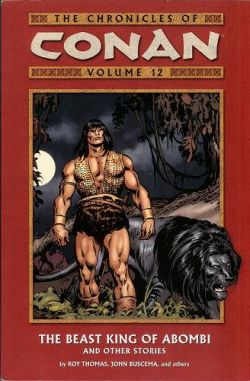Conan: The Beast King of Abombi and Other Stories
By Geoff Hoppe
July 19, 2007 - 21:32
Dark Horse Comics
Writer(s): Roy Thomas
Penciller(s): John Buscema
 |
| Berkeley the dog in a rare pre-Sesame Street gig. |
Conan fans genuinely do have reason to be glad at Dark Horse’s Conan series. After years of awful adaptations, the boys from
Dark Horse has also acquired the rights to publish the old issues of Marvel Comics’ Conan the Barbarian. Marvel’s Conan series was a gamble and a phenomenon. With the success of Lancer Publishing's resuscitated (and heavily edited) paperback Conan stories, the House of Ideas saw an opportunity. Conan was popular-- perhaps popular enough to front that rarest of rarities, the non-superhero comic. Marvel Comics gave it a shot, and the series ran for decades.
Volume 12 has the poor fortune of drawing on one of Conan’s least interesting yarns, Queen of the
Action hero Slab Squatthrust.
Queen of the
First, it’s patently offensive. The African sailors are objectified with the same casual racism that infected 1930s
Secondly, sexuality in Conan stories is both inevitable and inevitably boring. Sex was part of pulp literature. Stories sold because horny teenagers (and some adults) knew the pulps were a source of more-or-less legitimate, borderline erotica. Robert Howard knew this as well as anyone. It’s obnoxious, mostly because Howard’s love scenes are amateurish counterweights to his well-crafted fantasy and adventure scenes.
Conan: The Beast King of Abombi is a product of the famous team of writer Roy Thomas and artist John Buscema. This paperback collects nine issues of the regular series, including the entire adaptation of Queen of the
The plots (including the “Beast King” arc) are tame, but Thomas’ skill makes the stories entertaining. His competent mimicry of Howard’s style lends the comics legitimacy, and he expands on the mythology of Conan’s world admirably. While the story that introduces (and bids farewell to) the Beast King isn’t top-notch, the Beast King himself is an interesting character that could likely have been written by Howard himself. The elements of myth, prehistory, and communication with animals present in the yarn address Howardian themes, which makes the story yet stronger.
The Beast King loves delicious strawberry quik.
The layout is frustratingly cluttered. The best feature of the Conan stories is the fantastic world Howard created for the Cimmerian. The millennia-old, enigmatic dead cities and lush landscapes of Conan’s world are hurriedly portrayed. The focus falls on the people inhabiting the fantastic world, who are rarely as interesting as Conan. The frenetic layout also obscures Buscema’s talent. His finest moments are when he’s allowed to take up lots of space with large images, like the moving tableaux where Conan lights Belit’s pyre.
Worth the money? For fans, yes. Casual readers will do better to check out a Marvel Conan back issue before investing fifteen dollars in a collection.
Related Articles:
Review: Wonder Woman Conan #6
Review: Wonder Woman Conan #5
Review: Wonder Woman Conan #4
Review: Wonder Woman Conan #3
Review: Wonder Woman Conan #2
Review: Wonder Woman Conan #1
Review: Conan and Red Sonja #1 (2015)
King Conan: The Hour of the Dragon #3 Advanced comics review
King Conan: The Hour of the Dragon #2 Advanced comics review
King Conan: Hour of the Dragon #1 Advanced comics review
